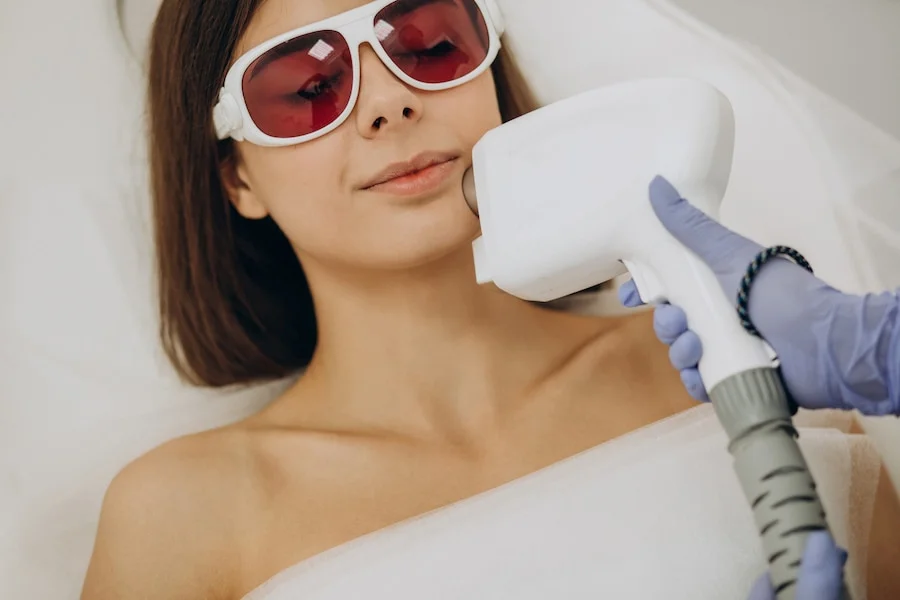If you’re tired of constantly shaving or waxing and are considering a more permanent solution for unwanted hair, you’ve likely come across electrolysis and laser hair removal as your top options.
Both methods offer a long-term alternative to traditional hair removal techniques, but they differ in how they work, how effective they are, and what kind of skin and hair types they suit best.
This in-depth guide will walk you through everything you need to know about each method, helping you make an informed decision that best fits your needs.
Table of Contents
ToggleWhat is Electrolysis?

Electrolysis is a method of hair removal that uses electric currents to destroy hair follicles, preventing them from growing hair in the future.
This technique has been around since the late 19th century and is the only method of permanent hair removal approved by Health Canada and the FDA.
How Electrolysis Works
The electrolysis process involves inserting a very fine needle into each hair follicle. An electric current is then sent through the needle, which generates heat to destroy the follicle’s ability to produce hair. There are three different methods, or modalities, used to achieve this outcome:
Types of Electrolysis
- Galvanic Electrolysis: Uses a direct electric current to create a chemical reaction that destroys the hair follicle.
- Thermolysis (Shortwave): Uses high-frequency alternating current to generate heat, effectively killing the follicle.
- Blend (Combination): Combines both galvanic and thermolysis methods to enhance treatment effectiveness.
Electrolysis has a long history dating back to the 1870s. Over the years, technological advancements have made it more effective and safer. Modern electrolysis machines offer more precise control over the electric current, reducing discomfort and improving results.
What is Laser Hair Removal?
Laser hair removal is a technique that uses concentrated light beams to target and destroy hair follicles, slowing or stopping hair growth. This method has become very popular because it’s fast and effective.
How Laser Hair Removal Works
During a laser hair removal session, a laser emits a specific wavelength of light that is absorbed by the melanin (pigment) in the hair.
The absorbed light turns into heat, which damages the hair follicle and delays or prevents future growth.
Since its introduction in the 1990s, laser technology has advanced significantly. Innovations like diode, Alexandrite, and Nd:YAG
lasers have made the procedure safer and more effective, making it suitable for a wider range of skin and hair types.
Cynosure’s Elite iQ: The Life-Changing Laser Hair Treatment
Types of Lasers Used
- Diode Lasers: Effective for a variety of skin types and hair colours, especially dark hair.
- Alexandrite Lasers: Known for their speed and efficiency, best suited for lighter skin tones.
- Nd:YAG Lasers: Ideal for darker skin tones due to their deeper penetration and lower melanin absorption.

At Dr. Lian Beauty, we use the Cynosure Elite iQ dual-wavelength laser for hair removal treatment for all skin tones including dark skin tone. The Cynosure Elite iQ laser technology combines two wavelengths – 755 nm Alexandrite and 1064 nm Nd: YAG.
Laser Hair Removal And Dark Skin: What You Need To Know
Comparing Effectiveness and Results Of Electrolysis And Laser Hair Removal
Electrolysis is well-regarded for delivering permanent hair removal results. By precisely targeting each hair follicle individually, electrolysis effectively destroys the follicle, thereby preventing any future hair growth.
Furthermore, electrolysis is versatile, working on all hair and skin types, whether light or dark, curly or straight. Unlike laser hair removal, which depends on the contrast between hair and skin colour, electrolysis can treat any hair, regardless of its colour.
On the other hand, laser hair removal offers long-term hair reduction rather than complete permanence. Although many people experience a significant and lasting decrease in hair growth, some fine or light hairs may eventually grow back.
Laser hair removal is particularly effective for those with dark hair and light to medium skin tones.
However, thanks to recent advancements, the procedure has become more accessible to individuals with darker skin tones, although its effectiveness on lighter hair colours remains somewhat limited.
What to Expect From An Electrolysis Hair Removal Treatment
Electrolysis can be a bit uncomfortable, often described as a stinging or prickling sensation.
How much it hurts can vary depending on your pain tolerance, the area being treated, and the type of electrolysis being used. Numbing creams and cooling methods can help make the process more manageable.
The length of each session depends on the size of the area being treated and the amount of hair. Smaller areas, like the upper lip, might take about 15 to 30 minutes, while larger areas like the legs or back can take several hours.
To complete the treatment, you might need anywhere from 15 to 30 sessions, usually spaced about 2 weeks apart.
What to Expect During Laser Hair Removal
The process starts with a consultation where a professional will evaluate your hair and skin type and discuss your goals for the treatment.
Before the procedure, you’ll need to shave the area to be treated within 24 hours of your appointment. This helps the laser target the hair follicles more effectively.
Why is Shaving Before Laser Hair Removal So Important?
During the session, a laser device will emit pulses of light that focus on the hair follicles, aiming to reduce hair growth. Afterward, soothing gels or creams are applied to the treated area, and you’ll receive aftercare instructions to help your skin heal properly.
You might feel something similar to a rubber band snapping against your skin or a mild burning sensation during laser hair removal.
The level of discomfort depends on the treatment area and your pain tolerance. Cooling devices, numbing creams, and specific laser settings can help make the process more comfortable.
Laser sessions are usually quicker than electrolysis. Small areas like the upper lip can be done in just a few minutes, while larger areas like the legs or back might take up to an hour. For the best results, you’ll typically need 4-8 sessions, spaced 4-6 weeks apart.
Book A Laser Hair Removal Consultation Session
Side Effects and Risks
Redness and swelling after electrolysis are pretty common, but they usually go away within a few hours.
These side effects are mild and temporary, especially with the right aftercare. However, if the procedure isn’t done properly, it can lead to issues like blisters, scabs, dryness, and ingrown hairs. Skin swelling (edema) is also possible.
Poor technique, particularly with thermolysis, can cause more serious problems like scarring, hyperpigmentation, or hypopigmentation, and in some cases, even long-term skin damage or infections.
To avoid these risks, it’s really important to choose a qualified, board-certified provider who can perform the procedure safely and effectively
Similar to electrolysis, laser hair removal can cause temporary redness and swelling in the treated area. These side effects typically clear up within a few hours to days.
Potential risks include changes in skin pigmentation, especially in those with darker skin tones, and blistering or burns if not performed correctly. Ensuring the procedure is done by a trained professional can mitigate these risks.
Electrolysis Suitability for Various Skin and Hair Types
Electrolysis is effective on all hair types, including light, fine, or sparse hair that may not respond well to laser treatments. This makes it a versatile option for people with different hair characteristics.
Electrolysis can be tailored to sensitive skin, but it requires careful handling to prevent irritation. A skilled practitioner can adjust the treatment settings to accommodate sensitive skin areas.
Laser Hair Removal for Various Skin and Hair Types
Modern laser technologies, such as Nd:YAG lasers, have improved the safety and effectiveness of laser hair removal for people with darker skin tones, reducing the risk of pigmentation changes.
Laser hair removal is most effective on dark, coarse hair. It’s less effective on light hair colours like blonde, grey, or white, as there isn’t enough melanin to absorb the laser energy.
How To Treat Hyperpigmentation After Laser Hair Removal
Comparing the Price of Electrolysis and Laser Hair Removal
Electrolysis usually costs between $30 CAD to $100 CAD per session, depending on the area you’re treating and the experience of the practitioner.
The total cost for complete treatment can range from $500 CAD to $4,000 CAD or more, depending on how many sessions are needed. Larger areas like the back or legs tend to be more expensive since they have more hair follicles to treat.
On the other hand, laser hair removal sessions generally cost between $200 CAD to $500 CAD each, depending on the treatment area and the clinic’s location. The total cost for a full course of treatment, which usually involves 4-8 sessions, can range from $800 CAD to $4,000 CAD
(These are general estimates, but your provider can give you a more precise quote.)
While laser hair removal may have a higher cost per session compared to electrolysis, it usually requires fewer sessions, which could make it more cost-effective in the long run.
Full pricelist for laser hair removal at Dr. Lian Beauty
Time Required for Electrolysis
Electrolysis involves a significant time investment, often requiring 15 to 30 sessions to achieve permanent hair removal, depending on the area and hair type. Since electrolysis works best on hair in its growing phase, sessions are typically scheduled 1 to 2 weeks apart.
As a result, the overall treatment period can extend over several months or even up to a year and a half. Each session lasts between 15 minutes and an hour, depending on the size of the area being treated.
The positive aspect is that once the full series of treatments is completed, the unwanted hair is permanently removed.
Time Required for Laser Hair Removal
Laser hair removal usually requires 4-8 sessions for effective hair reduction, making it less time-intensive than electrolysis.
Sessions are spaced 4-6 weeks apart to coincide with the hair growth cycle, allowing for faster overall treatment completion compared to electrolysis.
How Laser Hair Removal Works (A 7-Step Guide To Hair-Free Skin)
Pain and Discomfort Levels Compared
Sensitive spots like the upper lip, bikini line, and underarms might feel more uncomfortable during electrolysis.
The sensation can range from a mild tingling to a sharper sting. Using numbing creams, cooling gels, or taking breaks during the session can help ease the pain and make the experience more manageable.
Just like with electrolysis, laser hair removal can be a bit more uncomfortable in sensitive areas. However, most people find the pain to be less intense compared to electrolysis.
The good news is that advanced laser systems, like the Elite iQ dual-wavelength laser we use in our clinic, come with cooling features that help minimize discomfort. Plus, some laser hair removal providers apply numbing cream before the treatment to make the experience even more comfortable.
When to Choose Either Electrolysis or Laser Hair Removal
If you’re dealing with light hair or need precision for areas like your upper lip or eyebrows, electrolysis is a great option.
It’s perfect if you’re after a permanent fix and don’t mind committing to multiple sessions, offering lasting results for all hair and skin types.
On the other hand, if you’re looking to tackle larger areas like your legs, back, or chest—especially if you have dark hair—laser hair removal might be the way to go.
It’s faster, requires fewer sessions, and is particularly effective for those with dark hair and light to medium skin tones.
Making an Informed Decision
Both electrolysis and laser hair removal offer effective, long-term solutions to unwanted hair, but they each have unique advantages. Your choice between the two should consider your specific needs, skin type, hair colour, pain tolerance, and budget.
If you’re seeking permanent hair removal and have light hair or a small treatment area, electrolysis might be your best bet. However, if you’re looking for faster results with fewer sessions, laser hair removal could be the more suitable option.
For a personalized consultation and to explore which option is right for you, don’t hesitate to contact Dr. Lian Beauty.
Our team of experienced professionals can guide you through the process, ensuring you achieve the best possible results tailored to your individual needs.

Dr. Lian Peter, MD, MPH, CCFP, is a Family physician with a passion for aesthetics. In her aesthetic clinic, she provides a wide range of minimally invasive and non-invasive procedures, constantly honing her skills to deliver exceptional care and help patients attain their desired appearance.





